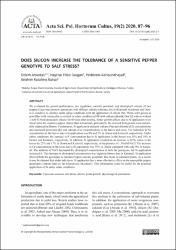| dc.contributor.author | Altuntaş, Özlem | |
| dc.contributor.author | Daşgan, Hayriye Yıldız | |
| dc.contributor.author | Akhoundnejad, Yelderem | |
| dc.contributor.author | Kutsal, IK | |
| dc.date.accessioned | 2022-03-10T10:55:33Z | |
| dc.date.available | 2022-03-10T10:55:33Z | |
| dc.date.issued | 2020 | en_US |
| dc.identifier.citation | Altuntaş, Ö., Daşgan, H. Y., Akhoundnejad, Y., & Kutsal, İ. K. (2020). Does silicon increase the tolerance of a sensitive pepper genotype to salt stress?. | en_US |
| dc.identifier.uri | https://hdl.handle.net/20.500.12899/583 | |
| dc.description.abstract | We evaluated the growth performance, ion regulation, osmotic potential, and chlorophyll content of two pepper (Capsicum annuum) genotypes with different salinity tolerance levels (Karaisali is tolerant and Demre is sensitive to salinity) under saline conditions with the application of silicon (Si). Plants were grown in pots filled with vermiculite in control or saline conditions [150 mM sodium chloride (NaCl)] with or without 2 mM Si from potassium silicate for 60 days after sowing. Better growth effects due to Si application were observed in the sensitive pepper Demre than in Karaisali, particularly, the root and fruit growth were remarkably enhanced in Demre. Furthermore, Si application reduced sodium (Na) and chloride (Cl) concentrations and increased potassium (K) and calcium (Ca) concentrations in the leaves and roots. The reduction in Na concentration in the leaves due to Si application was 9% and 2% in Demre and Karaisali, respectively. Under saline conditions, the increase in K concentration due to Si application in the leaves was 11% and 14% in Demre and Karaisali, respectively. In addition, Si application resulted in an increase in K/Na ratios in the leaves by 22% and 17% in Demre and Karaisali, respectively, in the presence of 150 mM NaCl. The increase in Ca concentration in the roots due to Si application was 55% in Demre compared with only 9% in Karaisali. The addition of NaCl decreased the chlorophyll concentration in both the genotypes, but Si application increased it. This increase in chlorophyll concentration was higher in Demre than in Karaisali. Si application allowed both the genotypes to maintain higher osmotic potentials than those in untreated plants. As a result, it may be claimed that under salt stress, Si application has a more alleviative effect on the susceptible pepper genotypes (Demre) than on the tolerant one (Karaisali). This information could be useful for the practical application of Si under saline conditions. | en_US |
| dc.language.iso | en | en_US |
| dc.publisher | UNIV LIFE SCIENCES LUBLINAKADEMICKA 15, LUBLIN 20-950, POLAND | en_US |
| dc.rights | info:eu-repo/semantics/openAccess | en_US |
| dc.subject | Capsicum annuum | en_US |
| dc.subject | salt stress | en_US |
| dc.subject | silicon | en_US |
| dc.subject | plant growth | en_US |
| dc.subject | physiological parameters | en_US |
| dc.title | Does silicon increase the tolerance of a sensitive pepper genotype to salt stress? | en_US |
| dc.type | Article | en_US |
| dc.department | MTÖ Üniversitesi, Ziraat Fakültesi, Bahçe Bitkileri Bölümü | en_US |
| dc.identifier.doi | 10.24326/asphc.2020.2.9 | |
| dc.identifier.volume | 19 | en_US |
| dc.identifier.issue | 2 | en_US |
| dc.identifier.startpage | 87 | en_US |
| dc.identifier.endpage | 96 | en_US |
| dc.relation.publicationcategory | Makale - Uluslararası Hakemli Dergi - Kurum Öğretim Elemanı | en_US |
| dc.identifier.wos | WOS:000537709000009 | en_US |
| dc.identifier.wosquality | Q4 | en_US |
| dc.indekslendigikaynak | Web of Science | en_US |


















